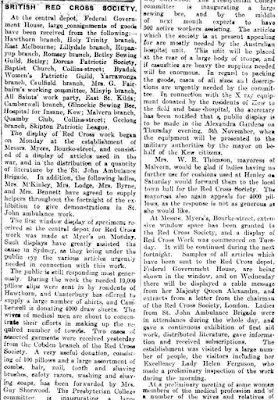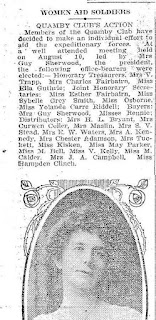The Home Front - Melbourne
Like many women in Australia, Adah Emily Sherwood, who was
to have her two youngest sons in uniform during WW1, took every opportunity to
assist the war effort at home in Melbourne. Adah contributed by organising
fund-raising events, purchasing comforts for the troops and with generous
donations. Most of Adah’s efforts during the war years were spent on the Anzac
Buffet but she also contributed to the Red Cross and through the Quamby Club.
The Anzac Buffet
See blog page: http://notmentionedindispatches.blogspot.com.au/p/adah-emily-sherwood-obiturary.html
The Anzac Buffet could be found at the No.5 Australian
General Hospital in St Kilda Road, Melbourne. It was started in August 1915 and
ran throughout the war years closing in November 1919. The founders were a
group of women led by Pattie Deakin (wife of the Prime Minister and directoress
of the Anzac Buffet), Jane McMillan (superintendent), Miss Irene Hawkins (Brigade
Leader) and a small group friends including Adah Emily Sherwood. They started
by providing refreshments to the soldiers waiting for embarkation as well as
those waiting to be seen at the hospital. Soon they were also providing advice,
clothing, small cash loans, rail tickets, and acting as advocates with the
authorities on behalf of individuals who needed assistance after their return
from overseas duty.
Some of these volunteer ladies attended the Anzac Buffet
every day. Initially, their basic equipment was limited to tea pots, cups,
saucers, an oil stove and an army bell-tent. With this they provided tea and
sandwiches, cake, pies, cocoa. By the end of the war they were serving over
1,000 soldiers a day for 1 penny each although it was the valuable support services which
were to prove so important.
The operation was financed by gifts in kind, donations and
volunteer assistance. The Anzac Buffet never needed to appeal to the public.
Volunteers worked together cleaning, preparing food, serving, washing up and they
used a simple administrative system and structure. There were no committee
members, no elections and only a simple accounting system.
As the number of returning soldiers grew so did the Anzac
Buffet’s support. An example was given of a soldier who grew up with only a
father in the remote outback. He enlisted in 1915 and found himself in
Melbourne before embarkation. He was introduced to the Anzac Buffet on St Kilda
Road and was befriend by Pattie Deakin. Three years later, after being wounded
in France, he was invalided back to hospital in England. He eventually returned
to Australia and was admitted to No. 5 Australian General Hospital. His nerves
were shattered, he was unable to speak, he had a tremor and his walk was
unsteady. After his discharge from hospital, he would regularly present violets
to Pattie who still remembered him after his long time abroad.
At
the time, many articles were written about the Anzac Buffet and the support
work carried out by the volunteers but no names were ever mentioned, at the
request of the women themselves.
Note this interesting paper: Kristen Thornton, Deakin University, September 2005,
‘Pattie
Deakin: from Prime Minister’s wife to ‘Intercessor in Chief’.
AWM image: H03343
The Red Cross
Adah Emily Sherwood also contributed to the Red Cross. The
Red Cross in Australia was started on 13 August 1914 by Lady Helen Munro
Ferguson wife of the then Governor-General. This new organisation grew quickly under her patronage and soon provided a range of assistance to injured soldiers
and those serving at the front. Voluntary Aid Detachments were formed based on
the British Red Cross system. These women were trained in first-aid and
home-nursing. They carried out unpaid domestic and assisted trained nurses in
hospitals and convalescent homes. Women also worked in the Wounded and Missing
Enquiry Bureau that tried to locate missing soldiers and airmen and send word
to their waiting families. [Adah would seek the help of the Missing Enquiry
Bureau in 1917 when trying to locate her third son, Harold Valentine Adams, who
was shot down over enemy territory and was missing for some months.] Volunteer women
also produced millions of pounds worth of hand-made clothing and other comforts
to the troops overseas via the Red Cross. After the war the Red Cross continued
to help by contributing to the health care of the sick, wounded and recovering
servicemen.
Adah was a keen supporter of the Red Cross. For example, on Monday 5 July
1915, The Argus newspaper in Melbourne reported on the "Red Cross Victorian
Appeal for Australian Sick and Wounded. The honorary treasurer of the fund (Mr
John Brice, Metropolitan Gas Company), acknowledged the following additional
contributions:
"Previously acknowledged £70,244 15d 6p
Mrs. Guy Sherwood £1,000
Victoria Amateur Turf Club, profits of June race meeting
£547 3d 9p"
and there is a substantial list of major donors which follows.
NATIONAL FUNDS. (1915, July 5). The Argus (Melbourne, Vic. : 1848 - 1957),
p. 6. Retrieved June 1, 2015,
Note
that Adah's donation of £1,000 pounds in 1915 is worth today over $100,000.
See on-line relative value calculator at http://www.measuringworth.com/australiacompare/
See on-line relative value calculator at http://www.measuringworth.com/australiacompare/
Other donations were made to the Red Cross by Adah Emily Sherwood. This is an example of goods in kind donation in October 1914.
BRITISH RED CROSS SOCIETY. (1914, October 5). Leader (Melbourne, Vic. 1862-1918), p.52 Ed. Weekly. Retrieved June 1, 2015, from http://nla.gov.au/nla.news-article92034759
The Quamby Club
On 10 August 1915 Adah organised a group of ladies at the Quamby
Club to support the war effort via the Ladies Work Association and St John
Ambulance Association. Note that this was only five days after the infamous battle of Lone Pine.
WOMEN AID SOLDIERS. (1914, August 15). Weekly Times (Vic. : 1914 - 1918), p. 14. Retrieved June 1, 2015, from http://nla.gov.au/nla.news-article121112032
The text of the article reads:
‘Members of the Quamby Club have decided to make an
individual effort to aid the expeditionary forces. At a well-attended meeting
held on 10 August, led by Mrs Guy Sherwood, the President….
Mr Greenwood, of St John Ambulance Association, explained to
members practical methods of helping the troops. He said there were two lines
of activity open to the women of Australia. Some were adapted to take up
nursing, others were clever with the sewing needle, machine or knitting needle.
Money was always needed to provide medical comforts and food. He submitted
patters of bandages, and other equipment for the Red Cross wagon which if
copied, would make practical gifts. Mrs MacDevitt, of the Ladies Work
Association, brought patterns of knitted balaclava helmets. These are the caps
made familiar to us by French aviators. They cover the head, ears and throat,
leaving the face exposed. It is the style of cap that deep-sea fishermen find
the most comfortable.
It was decided that members would set to work to make
cholera belts, mittens, bandages, shirts, night-shirts, cardigan jackets and
vests, socks and caps. One member suggested that some precaution should be
taken to see that the garments reached the soldiers, as in the South African
war half the comforts sent never reached their destination. A patriotic fund
was also opened. Before the meeting closed there was nearly £150 in hand.
'Mrs Sherwood suggested that an interesting
library might be provided for the outgoing troops, so that they could have
something to amuse them on the voyage. She offered to take upon herself the
task of collecting the books, then covering and distributing them. She proposed
that covers should carry the Kookaburra symbol, and that later they should be
sent to the field hospital in which Lady Dudley was interested.
Donations sent direct to soldiers
For the duration of the war, Adah continued to send monthly
packages of 'comforts' directly to Athol's unit. In May 1918, Harold Burke was
Captain of 'D' company, 5th Battalion. It is recorded that 'he had the privilege of
distributing the splendid cases of comforts so generously supplied
every month to D Company by Mrs Guy Sherwood in memory of her son, Athol
Adams, killed in 1917.'
'D' company was the unit in which Athol served during the Gallipoli campaign. Harold Burke was a fellow Old Melbourne Grammar boy
who was one of the first 5,000 to enlist in Melbourne, along with Athol, in August 1914.
Captain Harold Burke was killed 'whilst advancing with
company HQ on the left of E-W road in front of Peronne (on the Somme), 23
August 1918. Whilst turning to give an order for the company to advance, a
shell came over killing him outright and wounding several others. The head was
almost severed from the body and he was taken back by stretcher and buried near
Hamel. He was one of the very bravest and best and most popular. He had a
sister in the A.A.N.S and a brother in the Artillery.' L/C Jackson, B Company,
5th Battalion.
Australian Red Cross Society Wounded and Missing Enquiry
Bureau files,
1914-1918 War 1DRL/0428




No comments:
Post a Comment
I would be delighted if you would like to share your thoughts...